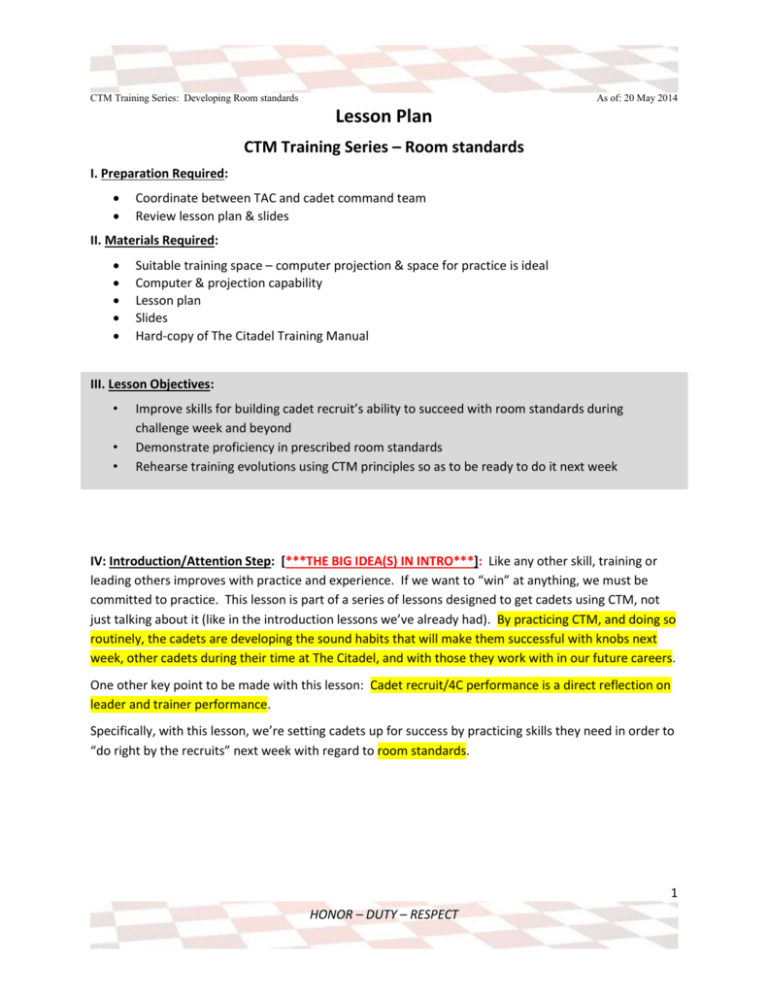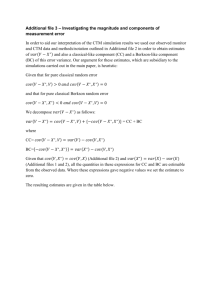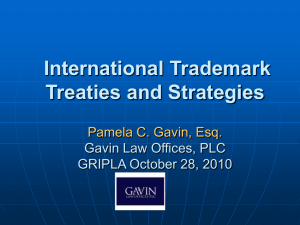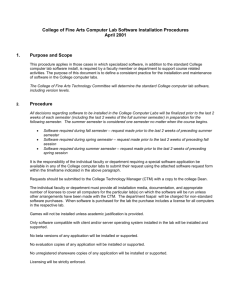Lesson Plan CTM Training Series – Room standards
advertisement

CTM Training Series: Developing Room standards As of: 20 May 2014 Lesson Plan CTM Training Series – Room standards I. Preparation Required: Coordinate between TAC and cadet command team Review lesson plan & slides II. Materials Required: Suitable training space – computer projection & space for practice is ideal Computer & projection capability Lesson plan Slides Hard-copy of The Citadel Training Manual III. Lesson Objectives: • • • Improve skills for building cadet recruit’s ability to succeed with room standards during challenge week and beyond Demonstrate proficiency in prescribed room standards Rehearse training evolutions using CTM principles so as to be ready to do it next week IV: Introduction/Attention Step: [***THE BIG IDEA(S) IN INTRO***]: Like any other skill, training or leading others improves with practice and experience. If we want to “win” at anything, we must be committed to practice. This lesson is part of a series of lessons designed to get cadets using CTM, not just talking about it (like in the introduction lessons we’ve already had). By practicing CTM, and doing so routinely, the cadets are developing the sound habits that will make them successful with knobs next week, other cadets during their time at The Citadel, and with those they work with in our future careers. One other key point to be made with this lesson: Cadet recruit/4C performance is a direct reflection on leader and trainer performance. Specifically, with this lesson, we’re setting cadets up for success by practicing skills they need in order to “do right by the recruits” next week with regard to room standards. 1 HONOR – DUTY – RESPECT CTM Training Series: Developing Room standards As of: 20 May 2014 Welcome to a discussion – and I mean discussion – on how we’re going to apply CTM principles to our training with cadet recruits. This lesson is designed to get us applying CTM, and in a way that prepares us for success next week. Before we get started, what’s the biggest concept you took away from the CTM academic training? o Possible answers: “Capital A” accountability: we feel responsible for the well-being and success of every recruit Good organizations value training because it leads to success and develops the future leaders of the team The five steps: expectations, skills, feedback, consequences, growth Training can be demanding and positive, purposeful, professional I’d like us all also to consider this concept: a recruit’s performance is a direct reflection of the trainer/leader performance. For this lesson, our focus is room standards. o Specifically, how do we develop our recruits so they learn and value/embrace room standards? o We’ll make sure we have the right level of proficiency ourselves o We’ll do some practice training. We’ll follow this overview: o Review of CTM o Review of the regulation o Practice 2 HONOR – DUTY – RESPECT CTM Training Series: Developing Room standards As of: 20 May 2014 V: Main Point 1: CTM is a five-step process, but success with CTM requires more than just memorizing the steps. The key to success is the CTM mindset. As a reminder, the mindset items on this slide are in the inside cover of the manual. Instructor(s) should briefly reinforce that strong organizations value training and that successful leaders, supervisors, trainers genuinely care about their people and will set conditions for their success o Recommend personal story: For example, the boss I learned the most from was also the most demanding one I ever had. He possessed the highest standards and his passion for the mission was awe inspiring. He was great at setting expectations and routine with feedback, some of which wasn’t so welcome at the time. That said, I never doubted that he genuinely wanted me to “get it” and to get better. Everything he asked me to do was consistent with the highest standards of the organization, would clearly help the organization succeed, and would be something he would also do himself. At the end of the day, he was demanding because he held me to those high standards every second of every day. He was a walking CTM-er, though I didn’t realize it at the time. He was demanding but professional and purposeful with positive intent in everything he did. With next slide (slide 6), instructor should emphasize the “boundaries.” As the personal story above indicates, simply doing everything that’s expected to the best of one’s ability is extremely demanding. There is no need to “invent” things to increase demands or stress on an individual o Critical to emphasize that an individual who operates outside the envelope within any organization has lost trust. It’s tough, probably impossible, to lead anyone when there is no trust. VI. Main point 2: Before we can be effective trainers, we have to be experts on the subject, to include the rules. That’s the price of admission to leadership. Before we can train to room standards, we have to know the guidance and direction given to us by the regulations The next two slides (slides 7-8) provide guidance on room standards. All the guidance comes from the White Book, Chapter 9 On first slide (slide 7), instructor should emphasize at least the following points: 3 HONOR – DUTY – RESPECT CTM Training Series: Developing Room standards As of: 20 May 2014 o Corps wide standardization. Pictures are provided in the white book which are to be used in training and inspecting. There is only one standard, not 21 different standards. These standards are to be learned during the cadre training period and no later than SMI 1. o How will we do that? Room standards are one part of a recruit’s transition to The Citadel. An effective training team phases in the learning to improve the chances for success. Through this, the effective training team helps a recruit prioritize and balance all the learning and skills With slides 8, instructor should review the prescribed room standards and highlight the first phase of learning. o Know and Model. o Demonstrate and apply the standards in your own room. After all, be the example/model the behavior is LEADERSHIP 101. VII. Main point 3: If we want our recruits to succeed, we have to prepare and practice our training skills. We have to practice both the skill and CTM. Instructor should guide the learning for each step of CTM. Slide deck built to allow instructor to: o Use first slide of each CTM step to generate discussion and new ideas o Use second slide of each CTM step to solidify or add to the cadet’s technique toolkit. o Note: for each CTM step, two-three areas are selected for discussion. This does not prevent an instructor for expanding the list. In addition to what’s on slides, instructor should emphasize the “QUICK-GOUGE CHECKLIST” items on each slide. Reasons are two-fold: o First, the checklist represents the key points for each step of CTM. We want cadets to understand what each step on the one-page checklist means. o Second, the checklist is testable material for CTM certification. IMPORTANTLY, THIS LESSON IS MOSTLY ABOUT PRACTICE. The training from here on out ought to emphasize cadets practicing the skills. A “discuss – let’s see a demo – let’s debrief the demo” construct is recommended. 4 HONOR – DUTY – RESPECT CTM Training Series: Developing Room standards As of: 20 May 2014 EXPECTATIONS: See slides, but also remind cadets about CAPT Abrashoff’s warning (CTM, p. 11), “Whenever I could not get the results I wanted, I swallowed my temper and turned inward to see if I was part of the problem.” SKILLS: See slides, but also remind cadets about MAJ Larson’s story (CTM, p. 22), “people do what you do, not what you say you do.” Modelling is a powerful leadership/training tool. 5 HONOR – DUTY – RESPECT CTM Training Series: Developing Room standards As of: 20 May 2014 FEEDBACK: See slides, but also remind cadets about Alina Tugend’s wisdom regarding feedback (CTM, p. 27): “Those who have studied the issue have found that negative feedback isn’t always bad and positive feedback isn’t always good. Too often, they say, we forget the purpose of feedback — it’s not to make people feel better, it’s to help them do better.” CONSEQUENCES: See slides, but also remind cadets about what makes negative consequences or punishment effective (CTM, p 33): o “Effective leaders, supervisors, and trainers establish over time an environment that demonstrates genuine care for the organization and the well-being of every person in the organization. They do this through individualized leadership, gaining a unique bond with everyone on the team, through presence and commitment, by perseverance, and by embracing standards. When the team knows we care, they know the motivation for punishment is pure and positive and purposeful.” o “Negative consequences or punishments can be helpful reducing undesired behavior. However, punishment only does half the job. Effective punishment needs to be combined with instruction, training, or rehearsal of the desired behavior.” 6 HONOR – DUTY – RESPECT CTM Training Series: Developing Room standards As of: 20 May 2014 consequences cont. GROWTH: See slides, but also remind cadets about Patton’s quote, some pretty good guidance when it comes to growth (CTM, p 41): "Never tell people how to do things. Tell them what to do and they will surprise you with their ingenuity." VIII. Summary/Take-Aways: See slide but emphasize OUR OBLIGATIONS AS TRAINERS. IT IS A SPECIAL TRUST. IX. Closure: Leaders/trainers have a sense of accountability, for themselves and others. That’s “Big A” accountability. Part of the personal accountability is to keep learning and maturing as a leader and trainer. Part of the responsibility to others is being prepared and ready. Cadet recruit/4C performance will be a direct reflection on our performance as leaders and trainers. Let’s be ready for the recruits next week. Attachments/Handouts/Supplement Reading (As Required) 7 HONOR – DUTY – RESPECT






